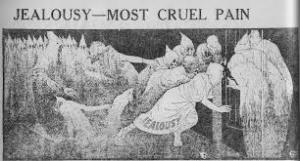Therapy For Jealousy
As a relationship therapist, I want to find ways that my clients can understand and master their jealousy, reducing the damage it can cause, and facilitating a process of personal and relational development. Jealousy is a stressful signal that partner differentiation and development in both could take place. At various points in this post, I describe ways of thinking about that for actual therapy.
Evolve And Grow
Jealousy’s underlying mistrust and insecurity can contribute strongly to the decline of a relationship. However, partners can also use their jealousy to evolve and grow. The learning process usually happens in a series of painful regressions. It often comes to whether one partner genuinely wishes to move ‘beyond’ jealousy, and lower its disorganizing anxiety.
Only A Threat
But if jealousy is experienced only as a threat – rather than as a tolerable emotional constant in a more mature relationship -a couple’s life will be harder. Your partner is not necessarily the only one responsible for your jealous reaction. The use of jealousy to manipulate one’s partner reflects the emotional fusion lying at the heart of the relationship.
What About Personal History?
What if your partner (or you) has a ‘history’ of ‘cheating’? What if one or both of you were ‘cheating’ in prior relationships, including this one? Isn’t some degree of jealousy just rational and self-protective when you or your partner have cheated in past relationships? That kind of narrative usually increases the likelihood and intensity of jealousy.
Three Levels Of Change
I like the idea of evolving or maturing beyond jealousy as a human relational concern, rather than repetitively suffering & recovering from it. Therapists should consider models of personal development that connect with social and relational change, including new social networks of all kinds.
Therapeutically, evolving and developing is not fast, easy stuff. Jealousy can be very entrenched, like a groove that’s been cut. It’s a slower moving function of both personal and relationship development. And it’s reinforced, by being socially constructed. So it’s got several levels and some complexity.
Poly Vs. Mono Jealousy
One issue to address upfront is the difference between monogamous and polyamorous (or monogamish) jealousy. Poly is designed in part to relieve jealousy by rationalizing it and making it transparent. But it doesn’t work out that easily in real life. People moving from mono to poly trade one set of jealousy and relational problems for another.
So I don’t take much time in this post for contrasting differences between poly and mono jealousies. They have many common personal elements. But poly is intentionally re-mapping relational life, and is now a distinctly social piece of development. It’s also likely adaptive in nature, reflecting longstanding doubts about how well monogamy works.
I acknowledge that this post is often written from a couples-centric perspective. If you are non-monogamous, you could consider jealousy as a sign that clarification is needed somewhere within existing agreements, rules & limits or boundaries.
Though mainly, I am after a different goal here: a multi-level map of jealousy.
A Big Mix
It isn’t typically understood as a blend of several emotional processes. With its various sub-types and supporting emotions, jealousy works its various ways through people’s weaker, more vulnerable sides, often during otherwise high levels of relational distress. No one seems to like the actual experience of it.
Jealousy in relationships presents fascinating connections between personal, relational and social psychologies. It’s a complex form of anxiety, so I will address each of these contexts and present a few published ideas about how this powerful dynamic, which mostly causes needless suffering, might be ‘mastered’ (outgrown via maturation.)
But before we get too theoretical here, I’m going to respond briefly to readers who came to this post seeking relief. I’ve often seen the level of anxiety that jealousy creates, and I want this blog to always be useful.
Basic Therapy You Can Do
I prefer to think about how we can learn from one another’s relationships, and I’ve addressed this in prior blog posts — here and here. Polyamory skills can be very helpful to monogamous couples. Franklin Veaux and Eve Rickert have a nice protocol for managing and eventually moving beyond basic jealousy. In fact, it can be used in any relationship.
“Negotiated avoidance” vs. “growth anxiety” models
Here’s another approach, from Kathy Labriola ( I’ve added my own alternative labels to hers in the sub-header above):
“When you discover exactly what triggers your jealousy, it puts things in perspective. Realizing that you are only jealous of a small piece of the overall picture makes it much more manageable. After identifying your jealousy triggers, you have two basic choices. You can “engineer the problem away” by making agreements with your partner to avoid that particular behavior or situation, as shown in several previous examples. Or you can use the “phobia model”, taking the risk of gradually exposing yourself to situations which trigger your jealousy in the hopes that you will learn to tolerate and eventually feel comfortable with it.”
More therapy will be covered further down. I hope your own therapy model will emerge in some ways, by looking at my multi-level “map” of jealousy.
I. THE INDIVIDUAL/PERSONAL CONTEXT
Here are some takes on the individual psychology of jealousy:
Existential
Jealousy anticipates the fear of being alone, and its emotional component, loneliness. These fears are existential, defined as a fear directly tied to existence. We could also say that the fear of death, the original existential ‘biggie’ is directly related. I agree, but hold that it’s a more emotional death. I cover the emotional deadness issue just a bit below.
Regressive
Jealousy is a painful regression. People usually regress in the face of a new, normal developmental challenges – problems they have never solved before. Like any regression, jealousy holds the potential to become a learning/maturing experience, a differentiating step forward. Where you manage the anxiety that exists between “I” and “Us”, a differentiation struggle in essential form.
Intense Or Morbid
Intense, or morbid, jealousy is a well known individual psychopathology. It’s both the degree of genuinely negative emotional (fear of loss), and behavioral disturbance (“protective” actions taken against possible loss.)
This type of jealousy has many moving parts: low self esteem, feelings of inadequacy, intense anxiety, self-protection, wounded trust, shame, dependency, attachment processes, low self-confidence, and chronic or acute emotional insecurity. High levels of neurologic stress result in disorganized perceptions, even delusions.
Attachment
In attachment theory, jealousy expresses the “anxious-preoccupied” type, which often leads to relationship partners getting stuck in a wounded, competitive, and early stage of development. I can see jealousy coming from a damaged, regressive attachment, where the importance of “the other person” to one’s sense of self is highly elevated. It usually presumes that the partner is there to “make” us feel alive at any time, as well as fulfill all other primary duties. This kind of attention to one another is a ‘sticky bind’, making it more difficult for the partnership to differentiate, especially via their erotic/sexual growth.
Differentiation
The bigger problem is that they will have greater difficulty differentiating, a move that would improve things sexually and mature the partners. Assisting partners through this stage is a task of differentiation-based therapy.
David Schnarch, describing one of his trainings, wrote: “”…affairs involve balancing the inherent tension between two sociobiological forces: We are a sexually gregarious species that also values pair-bonding. Differentiation, in this case, is your ability to tolerate, balance, and handle these two powerful drives.” (2014)
Hardwired, Genetic
Some hold that jealousy is “human” or “natural”, neurologically hardwired in a high percentage of humanity (which may lead some to search for, and ‘discover’ the ‘jealousy gene’.) Of course, differences in personal neurology affect how successfully people develop their intimate relationships. This belief is similar to the naturalist view of jealousy, that it’s a universally experienced human anxiety, literally existential (fundamental to the human condition) in nature. Veaux and Ricker realistically explore this and how to improve it in “More Than Two”
Reducing To Self-Diagnosis
Many relationships begin with two ‘cheating’ (or non-transparent) partners from their existing relationships. Either partner may have both relationship and family histories of infidelity, leading to divorce. This gives rise to self-diagnosis as a “jealous person” or a “serial cheater”. This oversimplifies and reduces things, and diminishes personal responsibility for actual jealous or “philandering” behaviors.
II. RELATIONAL CONTEXT
I’ll review a range of perspectives about relational sources of jealousy. This will lead to a broader social discussion.
Relational DNA
Jealousy is seen by some as inevitable in human relationships. Possession and competition both run deeply in humans. Attachment to others clearly involves possession. I often think of it rooted in our deepest neuronal memory (consider how newborns grasp.)
The “Third Person”
I’m referring to the fact that all (or 99%) monogamous relationships confront in some way the recurrent (or constant) phenomenon of the “third person.” [A less couples-centric term might be “other” or “new” person.] These “persons” always exist, or are created by the relationship partners in various ways.
Someone else, from one or both partners’ past or present, enters the emotional field of the relationship. Third parties (per Adam Phillips, author of Monogamy) accurately reveal the basic level of desire in a marriage, and other truths too. Some relationships may be highly reactive/poorly differentiated, others might take it more like an indifferent acceptance. And there may be accommodation of the “other”, also known as “poly”.
Behaviors
The behavioral response to a jealousy regression commonly takes the form of a parent/child dynamic, and it’s about loss of control. Partners can play “cop” or “detective” to one another. It’s like having live-in police; your partner becomes your parent, always one step behind, a frustrated relationship rescuer.
Never Jealous?
If jealousy were completely absent from a relationship, one might wonder if the partners are overly tolerant or accommodating, or even dissociative. Jealousy might be universal to committed relationships, because problems of attachment and possession are ‘normal.’
Deliberate Jealousy
Jealousy can be seen as a typical and constant dynamic that relationships tend to bring out in people. In fact partners sometimes deliberately create jealousy, to manipulate the other partner to re-commit, often for the sake of their (sexual) relationship. This is a competitive regression (which can be very exciting, like all competition, a/k/a “the chase.”) On a good day, this can lead to mind-blowing (and make-up) sex.
Kills Or Warps Sex
The dually destructive nature of jealousy is that it either strangles eroticism between the partners, or distorts it. There’s either not enough emotionally positive or imaginative space left in which to have fun, loving and interesting sex. Or, it can fuel anxiety-based sexuality, propping up a partner after a bout of insecurity.
Dependency Leads To Hostility
Jealousy expresses a profound dependency, therefore a huge emotional vulnerability. That stems from the fear of internal deadness, emptiness and/or rejection. The other partner is held as the source of happiness, to which one is entitled. A franchise is gradually imposed on that person’s time. This can only result in deep disappointment.
Fear Of Deadness
At the adult level, it’s a fear of deprivation – of feeling fully alive. Once that dependent deadness is experienced as threatening to a partner, emotional withdrawal/distancing is a common response. Jealousy is the other. Both are regressive defenses against deepening the intimacy and expanding the relationship. What’s missing? Mutual trust, defined as:
“Knowing that you can’t know everything about your partner. And being OK with that” (thanks again to Esther Perel.)
Trust & Self-Love
Also absent is self-validation, when an individual fundamentally knows he or she is lovable, whether loved or not by another adult. That secure state of self-love is not solely measured by what’s reflected from another person (Thanks here to David Schnarch, and the construct of the reflected sense of self.) As covered more below, this stance in some form is nearly necessary if one is living within the emerging social context of polyamory. A robust individuality is needed to live in a distinctly “relational” way.
Discussed Monogamy Lately?
As far as mastering jealousy, relationships that are able to thoroughly discuss the rigors of monogamy – as the commitment to each other develops – give themselves a distinct advantage against it reaching toxic levels.
So many other aspects of commitment are discussed by partners, but the actual rigors of exclusive fidelity are not often among them! The subject is so threatening for people that they bypass it altogether, opting for a broad and unrealistic taboo on discussion, as if it were a sacred cow.
It’s actually the elephant in the room. Jealousy can often be traced to a lack of mutual erotic awareness, which itself speaks to the level of both differentiation and overall development in a relationship.
Rite Of Passage
Jealousy may be a relational “rite of passage”. A single, sudden incident can drive a crisis, which the partners then mature in. It signals a stage of development forward, or not. The flip side is that jealousy can also kill relationships strictly on the strength of its anxiety. No one has to be actually discovered in an ‘affair’.
Couples, From A Social Perspective
As a lead-in to the next section on social perspectives, I offer Esther Perel‘s views on jealousy from the perspective of a couple in society:
“the couple has become the bulwark, the safe haven against all the insecurities away from a much larger community in which people had their needs met by a large network {bold added} and the couple was one interaction but not the central interaction, the organizing principle of our mythic and practical life. That today is the new marriage I would say.”
Laura Kacere has a take on couples in a social context, as she wrote in Everyday Feminism:
“When we see love as scarce, we are taught to see others outside of our relationship as potential competitors. Often, these are people of our same gender. Women, especially, are conditioned by our culture to see other women as their competitors.But we don’t have to see others in this way. In polyamory, there is ideally a freedom from this way of thinking that can also be very liberating. It can be hard to do, especially at first, but when you work to humanize the people your partner is interested in, seeing them as allies rather than rivals, you are liberated from having to be territorial and can come to see everyone around you in a different light.”
III. SOCIAL CONTEXT
We should know that predominant social views on monogamy and sexual exclusivity contribute to how people handle this issue in their relationships. Yet by looking at new ways of orienting ourselves socially, we may find additional ways to master jealousy.
Competitive Vs. Communal
I was intrigued by a recent article. I join the consensus that says it’s poorly written, yet still found its central idea intriguing: that personal jealousy is reinforced by a culture which values rugged individualism.
The author runs several victory laps with her enviable oh-so-not-jealous poly experience, as a springboard for her points of view about how to master jealousy. I think the real questions are not about ‘polyamory’. Despite its many flaws as a piece of writing, it does offer a glimmer of thinking and living differently about jealousy, asking questions like these:
- Does living within a more deeply collaborative framework of social support undercut the formation of jealousy?
- Does human collaboration counteract our most competitive or acquisitive traits and tendencies?
- Does a wider and/or deeper involvement in the lives of others facilitate the breathing space in relationships that allows desire to develop or maintain more easily?
Many Americans are convinced of their rugged individualism, or have otherwise been politically frightened off the idea of such a collective society. When there’s competition amongst adults for any resource, be it money, property or intimate partners, relationships more easily break down, due to competitive-type regressions (like “cop/detective”)
No “One And Only”
In terms of personal development, this more collective way fits a relational stance that does not believe in a “one and only” approach to partner selection. No one person has to satisfy all desires. Security and adventure in a relationship isn’t easily provided by the same person (Perel). We increasingly live in a choice-based world, where access to others on some level is easy to achieve.
Tend & Befriend
Collaboration & cooperation is an alternative to competitive and fight-or-flight models described above. It’s similar to “tend and befriend“. Adults who think and operate in a range of social networks trust those connections to provide for their needs and wants
So, the theory goes that adults who increase their level of social connection, are better insulated from competitive or possessive pressure, and better positioned to experience lower levels of jealous anxiety than the culture of constant competition. Networks with real relational viability
New Networks
- Can we believe that having very robust social support would grant us access to “sufficient” personal resources?
- Can we rely on collective and collaborative networks of people to meet our desires and needs?
The internet of course facilitates these connections, and to an unprecedented degree. The newest generation of adults has been effectively raised on it.
Therapy Connection
I do agree that the American social environment has become in some ways more isolated, fragmented and interpersonally less comfortable. There is a tension between a socially-based alternative to jealousy and, a therapy approach (relational therapy), which often seeks a more “individualized” solution.
I will leave you with lyrics from the recent song from Beyonce Knowles, “Jealous“








